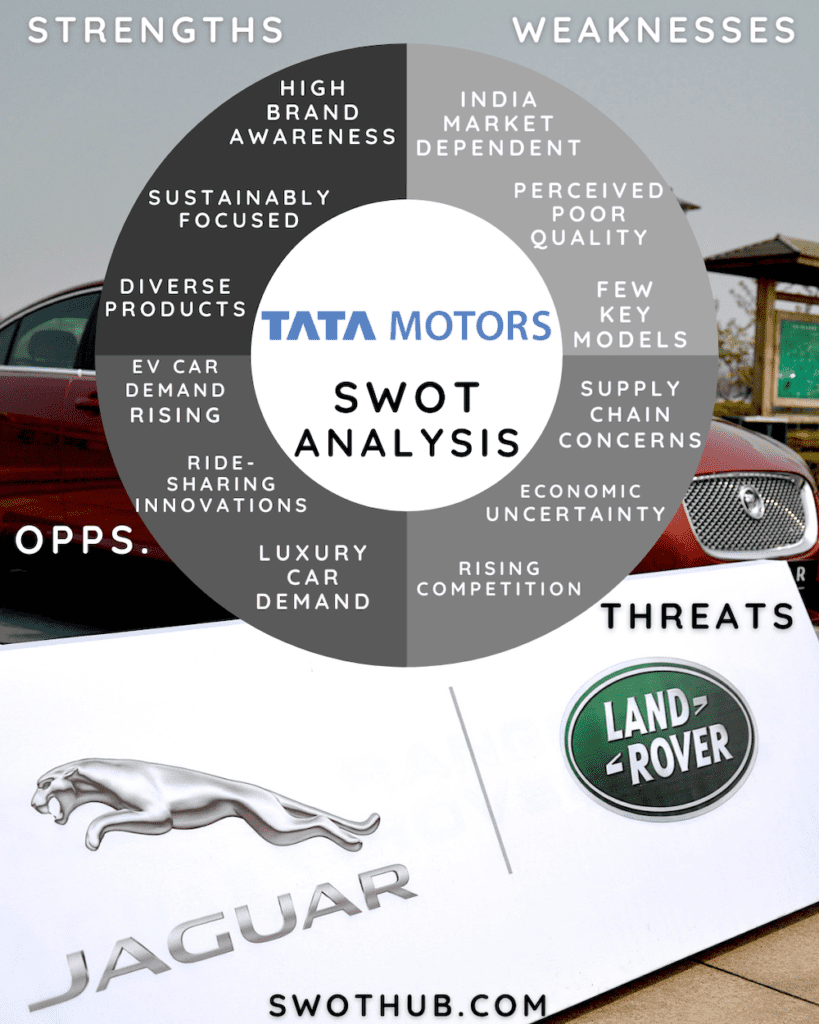The automobile industry worldwide has become a dominant market for innovation, safety, and fierce competition. In this SWOT Analysis of Tata Motors, we will look at how India’s Tata Motors, a subsidiary of the Tata Group, one of India’s oldest and largest conglomerates has become the leader in innovation and acquisitions of notable car brands like Range Rover and Jaguar. Look at how a Tata Motors SWOT analysis will reveal Tata Motors’ strengths, weaknesses, threats, and opportunities.
Table of Contents
Tata Motors History:
Tata Motors was founded in 1945 and initially started as a locomotive manufacturer. It entered the automotive industry in 1954 when it collaborated with Daimler-Benz to produce commercial vehicles.
When it bought the British luxury car brands Jaguar and Land Rover from Ford Motor Company in 2008, Tata Motors became well-known all over the world. With this acquisition, the company entered a crucial new phase as it expanded into the premium auto market.
The creation of the Tata Nano, which was marketed as the world’s cheapest car, is one of the notable ways that Tata Motors has revolutionized the automotive industry. The Tata Nano was introduced in 2009 with the intention of making personal transportation accessible to all Indians. However, insufficient marketing and safety concerns prevented the car from meeting its sales goals.
By making investments in electric and hybrid vehicles, Tata Motors has also had an impact. The company unveiled the Tata Indica Vista Electric Vehicle in 2010, making it India’s first electric vehicle. The company’s first all-electric vehicle, the Tata Bolt, was introduced in 2014.
In a SWOT Analysis of Tata Motors, they have also been recognized for their efforts in sustainable manufacturing. In 2018, the company’s Pune plant became the first Indian automotive plant to be awarded a Platinum rating for Leadership in Energy and Environmental Design (LEED) by the US Green Building Council.
Tata Motors is in a highly competitive market with both domestic and foreign competitors. It faces off against seasoned competitors like Maruti Suzuki, Hyundai, and Honda in the passenger car market. It competes with firms like Ashok Leyland, Mahindra & Mahindra, and Volvo in the commercial vehicle market.
Overall, Tata Motors has advanced the automotive sector significantly, especially in the fields of sustainable manufacturing and electric vehicles. In a market that is incredibly competitive and changing. The automobile giant still has to fend of Tata Motors’ competitors!
SWOT Analysis of Tata Motors At-A-Glance
| Company | Tata Motors |
| Industry | Automotive |
| Founder | Jehangir Ratanji Dadabhoy Tata |
| Year founded | 1945 |
| CEO | Guenter Karl Butschek |
| Headquarters | Mumbai, Maharashtra, India |
| Number of employees | 59,000+ (2022) |
| Revenue (FY 2022) | US $35 Billion (2022) |
Tata Motors Business Strategy:
SWOT Analysis of Tata Motors:
A SWOT analysis is a framework used to assess a company’s competitive situation and to create strategic planning. By taking Tata Motors’ strengths and weaknesses of Tata Motors’ as well as threats and opportunities of Tata Motors into account, we may better gain in-depth knowledge about the Tata Motors company. In this article, we’ll be taking a look at Tata Motors’s SWOT framework to better understand its competitive position and potential for future growth. See how Tata Motors’ competitors fare against them and learn about Tata Motors’ strengths, weaknesses, opportunities, and threats.
Tata Motors Strengths:
The areas where a company excels above average or in a manner that distinguishes it from its rivals are its strengths. Tata Motors’ strengths are outlined in this SWOT analysis. Some of its strengths compared to competitors include:
High brand awareness: One of the biggest and most reputable conglomerates in India is the Tata Group, which includes the Tata Motors subsidiary. The company’s logo is a representation of excellence, dependability, and innovation.
Diverse product portfolio: Tata Motors has a diverse product portfolio that includes commercial vehicles, passenger cars, and luxury vehicles. This allows the company to cater to a wide range of customers across different segments.
Sustainability-focused: In a SWOT analysis of Tata Motors, they prioritize sustainability, which has received praise for its work in environmentally friendly manufacturing. This gives us an advantage over rivals who might not place a high priority on sustainability.
Consultancy services: The consulting services offered by Tata Motors span a wide range of topics, including supply chain management, product design and development, manufacturing process improvement, market research, and business strategy. They assist clients in locating opportunities for growth and expansion, optimizing their business processes, and raising their level of market competition.
What are the strengths of Tata Motors?
Cost-effective manufacturing: Tata Motors has a reputation for cost-effective manufacturing, which allows the company to offer competitive prices to customers.
Powerful distribution network: Tata Motors has a powerful distribution network that covers India and other nations. As a result, the business can reach clients in various markets and geographic areas.
Tata Motors Weaknesses:
The weaknesses of a company are those that limit its potential, make it less competitive, and prevent it from achieving its goals. In this section of the SWOT Analysis of Tata Motors, we’ll look at Tata Motors’ weaknesses. In a SWOT Analysis of Tata Motors, some of its weaknesses compared to competitors include:
India market dependent: Despite its global reach, Tata Motors is largely reliant on the Indian market for its financial survival. As a result, the business is susceptible to changes in India’s economy and political landscape.
Limited brand recognition in the luxury segment: While Tata Motors has strong brand recognition in India, it is relatively unknown in the luxury car segment globally. This could make it challenging for the company to compete against established luxury car brands.
What is the weakness of Tata Motors?
Perception of poor quality: Even though Tata Motors has made great strides in raising the caliber of its products, some clients still believe that the company’s goods are inferior to those of its rivals.
Limited international presence: In a SWOT analysis of Tata Motors has a presence in several countries, but its international presence is limited compared to some of its competitors. This could make it challenging for the company to compete in certain markets.
Dependence on a few key models: The Tata Tiago and Tata Nexon are just two of the company’s key products that are heavily reliant on sales to generate revenue. Because of this, it is more susceptible to shifts in consumer preferences and market dynamics.

Tata Motors Opportunities:
Opportunities are external factors that can be leveraged by a company to gain an advantage over its competitors. In a SWOT analysis of Tata Motors against its competitors, some of its opportunities include:
Rising demand for electric vehicles: Tata Motors has already made significant progress in this area as there is a rising demand for electric vehicles on a global scale. The business now has the chance to diversify its product offering and gain an edge over rivals.
Increasing demand for sustainable manufacturing: There is a growing focus on sustainable manufacturing and reducing the carbon footprint in the automotive industry. Tata Motors has been recognized for its efforts in this area, and this presents an opportunity for the company to position itself as a leader in sustainable manufacturing.
Emerging Markets: In India, one of the world’s fastest-growing markets for automobiles, Tata Motors is well-represented. A growing portion of the company’s operations is also concentrated in other emerging markets, including those in Southeast Asia, South America, and Africa. Tata Motors has a chance to increase its market share in these areas as a result.
Ride-sharing and mobility innovations: There is an increasing focus on mobility solutions such as ride-sharing and car-sharing, which presents an opportunity for Tata Motors to innovate and offer new solutions in this area.
Luxury vehicle demand: In a SWOT analysis of Tata Motors, global demand for premium and luxury vehicles is on the rise, and Tata Motors’ purchase of Jaguar Land Rover puts the company in a good position to take advantage of this trend.
Tata Motors Threats in SWOT Analysis
Threats pose a risk to every company’s stability and profitability. Threats are external factors that can negatively impact a company’s performance and competitiveness. In a SWOT analysis of Tata Motors, some of its largest threats compared to competitors include:
Competition is fierce. Tata Motors faces fierce competition from both domestic and foreign players in the highly competitive automotive industry. Because of this, it is difficult for the business to keep its market share and profitability. Look at the Tata Motors competition later in this SWOT analysis.
Economic uncertainty: Economic uncertainty, particularly in emerging markets, can negatively impact Tata Motors’ revenue and profitability.
Changing regulations: The automotive industry is heavily regulated, and changing regulations can impact Tata Motors’ business operations and profitability. This includes regulations related to emissions, safety, and manufacturing standards.
Supply chain interruptions: Tata Motors is susceptible to supply chain interruptions, especially when it comes to vital components like semiconductors. Production and revenue for Tata Motors
Shifts in customer preferences: Shifts in customer preferences and trends can impact Tata Motors’ sales and market share. This includes changes in the demand for specific vehicle types such as sedans, SUVs, or electric vehicles.
What are the challenges faced by Tata Motors?
Due to the competitive automobile industry, climate Tata Motors’ competition is its biggest challenge. Take a look at their competitors.
Tata Motors competitors:
Tata Motors’ biggest competitors are both domestic and international players in the automotive industry.
Tata Motors major competitors include:
- Maruti Suzuki: Maruti Suzuki is the largest car manufacturer in India and a dominant player in the compact car segment. The company has strong brand recognition and a wide distribution network in India.
- Hyundai Motors: The second-largest automaker in India is Hyundai Motors, a South Korean business. The company’s product line is diverse, and its brand is well-known throughout the world.
- Mahindra & Mahindra: In the Indian SUV and commercial vehicle markets, Mahindra & Mahindra is a significant player. The business is well-established in the rural market and is known for its dependable vehicles.
- Honda Motors: In a SWOT Analysis of Tata Motors another competitor is Honda Motors, a Japanese multinational company that has a strong presence in India. The company has a diverse product portfolio, including compact cars, sedans, and SUVs.
Honda Motors is one of Tata Motors’ top competitors. Take a look here at the Honda SWOT Analysis

Tata Motors – Conclusion and Recommendations:
Recommendations for Tata Motors:
- Innovation: Tata Motors can continue to invest in research and development to innovate and introduce new products and technologies that can differentiate its products from those of its competitors.
- Quality improvement: Tata Motors can focus on improving the quality of its products to address the perception of poor quality among some customers.
- Brand building: Tata Motors can focus on building its brand recognition globally, particularly in the luxury car segment. This could involve sponsorships, partnerships, and marketing campaigns.
- Strategic partnerships: Tata Motors can form strategic partnerships with other companies to expand its product portfolio and distribution network.
- Focus on sustainable manufacturing and electric vehicles: Tata Motors can continue to invest in sustainable manufacturing practices and electric vehicles to meet changing customer preferences and regulatory requirements.
FAQs for Tata Motors
What are the major challenges of Tata Motors?
Tata Motors faces challenges such as intense competition in the automotive industry, fluctuating raw material prices, and the need to adapt to rapidly evolving technology trends like electric vehicles.
What are the strengths of Tata Motors?
Tata Motors boasts a strong global presence, a diverse product portfolio, a focus on innovation, and a commitment to sustainability through its electric and clean energy initiatives.
What is the risk analysis of Tata Motors?
Risk analysis for Tata Motors includes market volatility, regulatory changes impacting emissions and safety standards, currency exchange rate fluctuations, and supply chain disruptions, which are crucial factors to monitor for the company’s strategic planning.
In conclusion, Tata Motors operates in a highly competitive and rapidly changing industry, but the company has several strengths and threats that give it an advantage over its competitors.
Overall, Tata Motors has demonstrated an ability to adapt to changing market conditions and address challenges, and its recent efforts in sustainable manufacturing and electric vehicles show that it is well-positioned to maintain its competitiveness in the industry.





